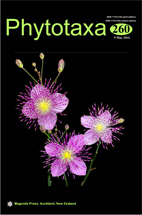Abstract
Thirty-four Lycoperdon specimens from Korea were examined with the internal transcribed spacer (ITS) region of ribosomal DNA sequence data. The result of the ITS sequences phylogenetic analysis indicated that the Korean specimens represented nine different species. To confirm the taxonomic position of these species, we conducted an intensive morphological investigation, and additional phylogenetic investigation of the protein coding regions RNA polymerase subunit II (RPB2) and translation elongation factor 1-alpha (TEF1). We discovered two new species (L. albiperidium and L. subperlatum) and one (L. ericaeum) newly discovered in Korea. Lycoperdon albiperidium is closely related to L. ericaeum based on ITS, RPB2 and TEF1 sequence data, but these species were distinguishable by morphological characteristics, especially the shape of the basidiocarps, the diameter of the eucapillitial threads and the size of the basidospores. Lycoperdon subperlatum is quite similar to the European and American L. perlatum based on morphological characteristics. However, L. subperlatum is clearly distinct from European and American L. perlatum based on ITS, RPB2 and TEF1 sequence data, and somewhat differs from them in macro- and microscopic characteristics. Based on morphological characteristics, L. ericaeum is related to L. subumbrinum and L. lividum but it is distinguishable by the presence of fragile, eucapillitial threads, the diameters of the threads and ITS sequences. Here, we describe four Lycoperdon species collected in Korea.

